


| Peter Upton's |
Subbuteo Tribute Website. |
The rulebook to the OO scale edition states "After months of research we completely redesigned Subbuteo rugby, and our development Department produced what we believe is the only real table-top 'rugger' game in existence". Certainly rugby is a hard game to recreate outside of computer games, and both these simulations can be frustrating to play. However, overall I think Subbuteo did a good job. Of course it isn't as free-flowing as the football game, and there are things missing (no rucks or mauls), but it is flexible enough to cope with both league and union rules. I think rugby league probably works the best, as the free flowing nature suits the game, although I'm not an expert on either code, and there may be many things lurking in the league rules that Subbuteo can't handle.
1950's Rugby Editions.



This version was played with flat tokens, like draughts. A sheet of cut-out paper stickers was provided, so that each disk could feature a picture of a player. An attractive pair of metal rugby posts were provided, along with one standard card figure and base (designed like the cricket bowler) to take the penalty goals. The 1957 companion sports leaflet says "Table soccer and table cricket principles would not suffice for this most difficult of all reproductions of an outdoor game". Quite right, but it doesn't explain what principles are used. There's a reason for this, as like the simple racing games of the 1950s the reality is different to the hype. The game is really a matter of rolling the tokens at each other, and it's a very basic game. (go to the 1950s rugby rules page for details on how this game was played).

As always with Subbuteo though, this was a well presented game. The pitch (if provided) was the usual quality cloth, and the metal goals with white celluloid tubing was as effective as they were in the football version. The player tokens are petite, but do have "Subbuteo" embossed on them. The ball is dark brown, and smaller and less detailed than in the 1970s sets. It is perfectly usable though.
Unlike football and cricket, only two versions of the 1950s rugby were made, simply with or without a pitch. The pitch version had a double sized box to make room for the pitch, (but it is much thinner).
| Standard Edition: | Price in 1957 18/- (post free!) |
| Standard Edition with marked out pitch: (De Luxe Version) | Price in 1957 an impressive 39/- Time to get the army blanket out! |


The advert for this game continued in the Companion Subbuteo Sports Games leaflet right up to 1968, the year before the more familiar OO scale version was introduced. Amusingly, the familiar advert still calls it "another new Subbuteo ball game!", when clearly it wasn't. At that point, the standard edition had increased in price to 19/11d, and the "with pitch" version was 42/6.
OO Scale Rugby Editions (1969-1982).
Open the box, and it looked even more like Subbuteo. This was mainly because the players were essentially the same as the footballers, and the goals were of a similar design (indeed they share a base with a set of football goals). The "flick to kick" style of play was translated across too. As anyone who has played the game will know, this is far from ideal because there is not a lot of kicking in rugby, and the "flick" therefore has to represent a player running with the ball. However, the small rugby ball is not ideal for this purpose. This means that the game is often slow and bogged down. The very defined offside line in rugby, and fact that the whole team needs to move up with this line adds to the problems.
Whilst the "flick to kick" part of the game is more than a little frustrating, the new inventions added to the set proved to be great fun. The "scrummer", credited as essentially the reason the set was produced, is a neat solution to this distinct rugby set-piece. The players stand around the edge of this large rugby ball shaped device, the ball goes in the middle, and then rolls out a random hole for one side or the other. The other lovely new item was an oversized kicker for taking penalties and conversions.
If you want more details on playing this version, I have a Rugby rules (OO scale) page you can visit.
Whilst a familar part of the famous 1970s Subbuteo range, only three different editions were ever produced, and throughout most of the production run only the International Edition was available. Subbuteo Sports Games never produced a large set featuring the extra accessories. Why this was, I don't know. It is especially strange when you consider that cricket gained a floodlighting edition, but it was rugby that had the floodlights in its accessory range.
International Edition.
This was the basic set, with the essentials required to play the game. It was fooling no-one being called "International Edition", it was a club edition pure and simple and the size of the box makes this very clear. As with most of the long-lived Subbuteo sets, this box set goes through several variations. The "hand-assembled" nature of Subbuteo means that different exteriors and interiors seem to overlap and get muddled up, but I've tied the set down to four main variations - three box types, plus the early kicker variation.
The International Edition was priced at 75/- in 1969, so it was more expensive than the Test Match cricket at 72/6, which perhaps explains why the word "club" was avoided. However, it did put it nearer to the football club edition price (65/-) than the next set up in that range (Floodlighting set 95/-)
1. International Edition "NEW!" version (circa 1969-71)


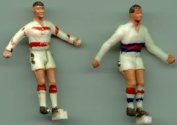
The "New!" box lasted for a number of years, but if you want the very first edition it is recognisable because -
There are later editions in the same "new" box as the first edition, but the set received tweaks.
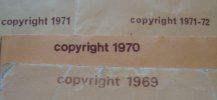
2. International Edition (Tunbridge Wells address. Circa 1971-77)
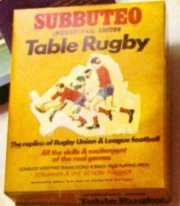

This similar looking edition was the standard early 1970s version. Whilst it has a distinct colour (more of a brown than an orange), the obvious change is that it no longer has "New!" on the lid.
3. International Edition (Chiddingstone Causeway, Tonbridge address 1977-80)



In 1977, Subbuteo Sports Games changed their contact address from Tunbridge Wells to their main factory in Chiddingstone Causeway, Tonbridge. In photographs, this Tonbridge set looks the same as the previous one, but actually it is a thinner box - both in depth and in the cardboard used. Oddly, this set shares catalogues space and release dates with a new look set (which is shown below). So this version featured in the 1977 catalogue, but not the related box set brochure. It doesn't appear in the 1978 catalogue, but returned in 1979, and both editions were in different pictures in 1980. Like the football and cricket sets of the same vintage, this set began with a thin cardboard insert (making the whole box rather squashable) but soon gained a polystyrene inner (at least by 1979, and maybe earlier)
4. Subbuteo Table Rugby (new box lid. Circa 1978-82).
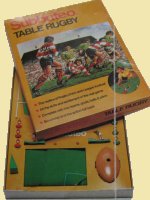

This was the last version produced, and matched the other sport box sets of the late 1970s, and also the Rugby Sevens set that was introduced in 1980. The set has a couple of early pictures in the catalogues (circa 1978), but shares catalogue appearance with the previous version, and editions with 1970s contents seem thin on the ground. You are much more likely to see this one with the 1980s contents of red/white and blue/white lightweights, and paperwork from that era.
Rugby Sevens/Display Edition.
There were only two other editions of OO scale rugby produced. Both were cut down from the International set, and included seven-a-side teams. Both had a very short shelf life.
Display Edition (1971-73)
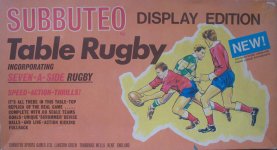

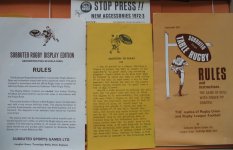
Display Edition: This was an odd little set, available for just two years. It was standard for Subbuteo Sports Games at the time to produce a cheaper Display Edition of their games. The football and cricket versions were basically a club edition, minus the pitch to keep the cost down, produced in a compact box.
Whilst the late arriving Rugby Display Edition was also pitch-less, it tried to do something different. For starters, it had a unique box, which was longer, and flatter than other sets of the period. Open the lid, and as you can see by the illustrations, it was a well presented set, really suitable for a "display edition". It did something else unique too. Instead of being a pitch-less version of the standard game, this one was sold as a seven-a-side edition. On top of this, only one kicker "in neutral white strip" was provided to be used by both sides. Note that he is the early style of kicker with the extra rest, which had disappeared from the International Edition by this date. It might have been an excuse to not include a wedge. It was obviously felt that the pitch alone didn't reduce costs enough for a set with large teams, and essential extra pieces.
As this in an early 1970s set, the teams supplied were the proper rugby figures, and are in interesting club colours. Usually, these are Bradford Northern and Castleford (as shown here). As the set had a short run I don't think there is too much variety to the teams.
My version came with the 1971 rule book, and an extra sheet explaining some rules for the seven-a-side game (as well as the yellow typed "scoring a try" rule sheet). The new rules don't add much (suggest 7 minutes a side), and were added to the full rule book for a further 1971-72 revision, which I assume was added to later editions. Mind you, my set also has a "stop press" 1972-73 football sheet added as well....
This one was very short lived. It was introduced in the 1971-72 catalogue at a price of £1.70 compared with £3.90 for the full International edition (the football display was the same price, while the cricket display was £1.40). It still featured in 1972-73, but perhaps worryingly the cricket display edition had been dropped. The following year's lovely poster catalogue had no sign of this set at all.
Rugby Sevens (1980-82)
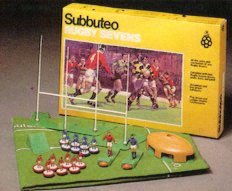



Rugby Sevens: No seven-a-side set appears in the catalogues dated from 1973 to 1979. However, a second edition was produced in the final 1980-82 "golden period" of Subbuteo production. Illustrated above, this version has a kicker for each team, a kicking wedge, and a pitch. That meant that it didn't end up much cheaper than the full set (£9.25 in 1981 compared with £12.50 for the International edition). One interesting thing of note is that this set has a small pitch like five-a-side football game Top Scorer, although proper seven-a-side rugby is actually played on a full size pitch.
That's it for the boxed editions. The accessories and teams have their own pages, as do the rules, so please follow the links to enjoy more of the rugby range.